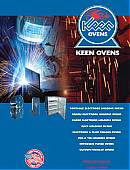Industrial Ovens
Front-Loading
![]() Under 10 cubic feet
Under 10 cubic feet
![]() 10-20 cubic feet
10-20 cubic feet
![]() Over 20 cubic feet
Over 20 cubic feet
![]() See All
See All
Top-Loading
![]() Under 10 cubic feet
Under 10 cubic feet
![]() 10-20 cubic feet
10-20 cubic feet
![]() Over 20 cubic feet
Over 20 cubic feet
![]() See All
See All
Learn About Our Industrial Ovens
Welding Ovens
![]() Stick Electrodes
Stick Electrodes
![]() Sub-Arc Flux
Sub-Arc Flux
![]() Wire Spools
Wire Spools
![]() Tig Filler Wire
Tig Filler Wire
![]() Multi-Purpose
Multi-Purpose
![]() Nitrogen Purge
Nitrogen Purge
![]() See All
See All
 Order Our Free Catalog Today Click Here |
| Available Inventory |
Aspects of Flux-Cored Arc WeldingAs its name implies, flux-cored arc welding is a type of automatic or semi-automatic arc welding process which uses a tubular electrode containing a flux rather than a solid electrode. This flux cored electrode makes FCAW the ideal choice for many of today’s welding requirements. There are two types of flux-cored arc welding: one that requires an external supply of shielding gas and one that is self-shielding. The self-shielding type of FCAW gets its shielding gas from the continuously-fed tubular electrode. Not only does this electrode contain flux, it also contains ingredients that generate a shielding gas as the electrode comes into contact with the extreme heat of the welder. The gas protects the arc and the molten metal from the atmosphere. Benefits of FCAWFCAW has several advantages over other welding methods. For instance, Flux-cored arc welding has a higher deposit rate than MIG welding. In fact, it can deposit at least three times the amount of weld per hour than MIG welding. There are also fewer restarts with FCAW, decreasing the chance of defects in the restart area. In addition to having a high deposit rate, flux-cored arc welding can be performed outdoors, even in windy conditions, and still produce a strong, quality weld. This benefit makes FCAW a popular choice in the construction and farming industries. The electrode used in FCAW sticks out longer than the wire used in gas metal arc welding. This allows the welder to see and control the molten puddle much easier. Flux-cored electrodes contain deoxidizers that reduce or eliminate porosity in welds. The FCAW process can be performed in all positions with the right consumable electrode. FCAW TipsFlux wires for FCAW range in size from 0.035 inch to 1/8 inch in diameter. The most commonly used wire in FCAW measures 0.045 inch in diameter. The larger wire makes it possible for the welder to weld at a higher current level. A porous weld is a weak weld. Although FCAW wires contain deoxidizers, it is still a good idea to properly clean the weld area to ensure prevention of weld porosity. This means removing dirt, oil, rust, paint or coating, grease, and any other debris from the metal. To get the desired weld results, maintaining the proper heat input is typically necessary. This can be achieved by keeping a consistent travel speed of the weld, as well as a consistent current or voltage. Additional Aspects of FCAWFlux-cored arc welding cannot be used to weld non-ferrous exotic metals, including aluminum. However, FCAW works well on most carbon steels, nickel-based alloys, cast iron, and some stainless steels. Self-shielding electrodes emit toxic fumes. When working with this type of electrode, the welder needs to have proper ventilation in the work area or to use a protective, sealed mask that provides fresh air. Resources: Lincoln Electric Co. Related Articles: Flux-Cored Wire versus Solid Wire What is Flux-Cored Arc Welding?
|